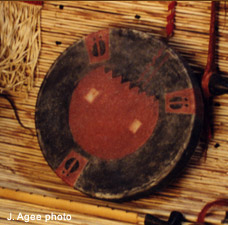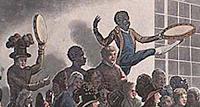Instruments resembling tambourines are mentioned several times in the journals, but always in descriptions of Indian music, except for Sergeant Ordway’s comment on New Year’s Day of 1805. In the absence of evidence that any of the men carried their own, it seems likely that Ordway borrowed one from an Indian, or even traded for it.
On 26 September 1804, for example, at Bad Humored Island near today’s Pierre, South Dakota, Clark described how the day’s negotiations with the Sioux ended:
“We Smoked untill Dark,” wrote Clark, “at which time all was cleared away & a large fire made in the Center. Several men with Tamborens highly Decorated with Deer & Cabra [pronghorn antelope] Hoofs to make them rattle, assembled and began to Sing & Beat.”
Thus Clark, who otherwise shows no sign of musical knowledge, hints that he has been to dances back home, and he knows what a tambourine looks like.
One of the oldest and simplest musical instruments in the world, the tambourine was as ubiquitous in Lewis and Clark’s time as it was in ancient Assyria, Egypt, India, China, Greece or Rome, and as it is in our own time, and still primarily in dance music.
Its common name is French fortimbrel, which is a synonym fortaboret,both of which are mentioned in the Old Testament, where they denote the instrument of angels. In everyday life, however, it was commonly associated with wandering minstrels, showmen, and jugglers.
It has appeared in many styles and sizes, usually round, but sometimes square; usually with a skin stretched over one side, sometimes over both sides; occasionally with gut strings called “snares” stretched across the underside of the drum head, more often without; some with “jingles” inserted in the frame or attached to it on the outside; some without.
The modern tambourine is typically between eight and 12 inches (20-30 cm) in diameter, occasionally twice that size. It is usually struck with the fingers, or against the player’s body, but it may also be struck with a small beater.
At extreme right is a player who seems to be directing his stroke toward the rim of his tambourine, where he can accentuate the sound of the jingles suspended in its rim. The player to his right has braced his tambourine against his shoulder, and is about to strike it vigorously with his upraised right hand.
We cannot tell what the other two men are contributing to the performance, but the one at extreme left appears to have a stick in his hand, perhaps a beater for a small tambourine hidden from our sight behind the man to his left. The latter, apparently clapping the rhythm, may be the caller for the round-dance.
The tambourine player at right strikes his instrument alternately with his foot and his hand. Blacks who had talents as entertainers were extremely valuable, and were usually accorded privileges unavailable to other slaves, such as the wearing of fine livery.
The stylishly dressed gentleman at left is similarly making quite a bit of noise with his large tambourine, which also has jingles around it.
The role of the black man between them is not clear, but if we could see his hands we might discover he’s playingbones made of small animal ribs or flat hardwood sticks. They were also called “clappers” or “knicky -knackers.” The player would have a pair of them in each hand and would strike them together by twos or by fours to create intricate rhythms resembling the sounds of castanets, adding ripples of variety to the grosser sonorities of the tambourines.
Experience the Lewis and Clark Trail
The Lewis and Clark Trail Experience—our sister site at lewisandclark.travel—connects the world to people and places on the Lewis and Clark Trail.
Discover More
- The Lewis and Clark Expedition: Day by Day by Gary E. Moulton (University of Nebraska Press, 2018). The story in prose, 14 May 1804–23 September 1806.
- The Lewis and Clark Journals: An American Epic of Discovery (abridged) by Gary E. Moulton (University of Nebraska Press, 2003). Selected journal excerpts, 14 May 1804–23 September 1806.
- The Lewis and Clark Journals. by Gary E. Moulton (University of Nebraska Press, 1983–2001). The complete story in 13 volumes.




